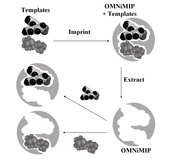Highlight
Molecular Imprinted Polymers
Achievement/Results
One monomer molecularly imprinted polymers (OMNiMIPs) have enhanced binding and selectivity properties versus traditionally formulated EGDMA/MAA imprinted polymers. Further comparison was investigated toward multi-analyte imprinting capability of these two imprinted materials. Two templates,®-()-1,1’-bi-2-naphthol and BOC-L-tyrosine were simultaneously imprinted in the polymers, and the enantioselectivity compared to polymers imprinted with one template at a time. The simultaneously imprinted OMNiMIP exhibited only 6.3% and 21.1% loss in enantioselectivity for®-()-1,1’-bi-2-naphthol and BOC-L-tyrosine respectively, versus the singly imprinted OMNiMIPs. For the EGDMA/MAA imprinted polymer, enantioselectivity was only found for®-()-1,1’-bi-2-naphthol, with 59.1% loss in enantioselectivity found for the multiple-template imprinted polymer versus the®-()-1,1’-bi-2-naphthol singly imprinted polymer. It was also shown that imprinting two templates simultaneously leads to better enantioselective performance than mixing the particles of singly imprinted polymers. For example, the enantioselectivity of for the R enantiomer of 1,1’-bi-2-binapthol on the simultaneously imprinted OMNiMIP gave a separation factor value of 4.4, while the mixed-particle column gave a value of 2.6. In addition, it was found that mixing an imprinted polymer with a non-imprinted polymer resulted in complete loss of chromatographic enantioselectivity in all cases (except one that still showed severe loss of selectivity). Collectively, the results illustrate that imprinting mixtures of templates simultaneously is the method of choice, especially for OMNiMIPs, for producing multi-analyte molecular recognition in imprinted polymers.
Address Goals
Materials designed to recognize the presence or absence of molecules are essential for developing miniature sensors that will ultimately permit devices to respond to various environmental conditions, whether these be biological threat agents or chemicals produced during normal or abnormal cell function.






